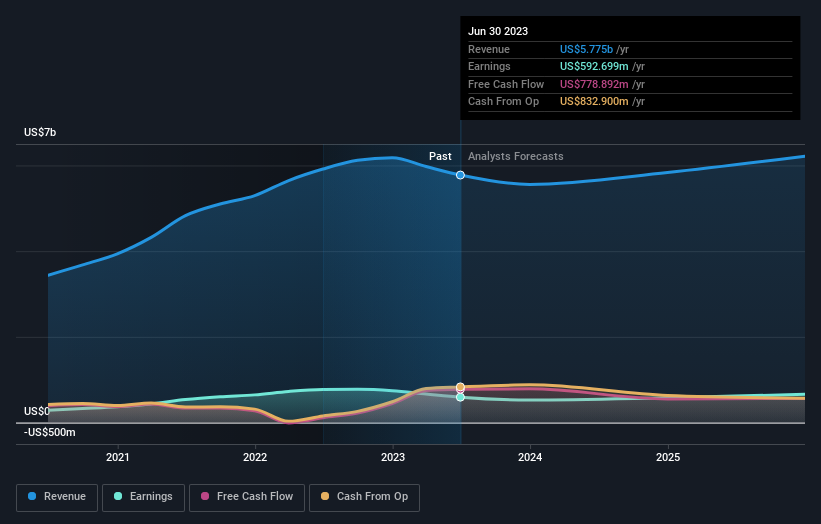- United States
- /
- Retail Distributors
- /
- NasdaqGS:POOL
Should You Think About Buying Pool Corporation (NASDAQ:POOL) Now?

Pool Corporation (NASDAQ:POOL) received a lot of attention from a substantial price movement on the NASDAQGS over the last few months, increasing to US$388 at one point, and dropping to the lows of US$334. Some share price movements can give investors a better opportunity to enter into the stock, and potentially buy at a lower price. A question to answer is whether Pool's current trading price of US$346 reflective of the actual value of the large-cap? Or is it currently undervalued, providing us with the opportunity to buy? Let’s take a look at Pool’s outlook and value based on the most recent financial data to see if there are any catalysts for a price change.
Check out our latest analysis for Pool
What Is Pool Worth?
Pool appears to be expensive according to my price multiple model, which makes a comparison between the company's price-to-earnings ratio and the industry average. In this instance, I’ve used the price-to-earnings (PE) ratio given that there is not enough information to reliably forecast the stock’s cash flows. I find that Pool’s ratio of 22.81x is above its peer average of 15.24x, which suggests the stock is trading at a higher price compared to the Retail Distributors industry. Furthermore, Pool’s share price also seems relatively stable compared to the rest of the market, as indicated by its low beta. If you believe the share price should eventually reach levels around its industry peers, a low beta could suggest it is unlikely to rapidly do so anytime soon, and once it’s there, it may be hard to fall back down into an attractive buying range.
Can we expect growth from Pool?

Investors looking for growth in their portfolio may want to consider the prospects of a company before buying its shares. Buying a great company with a robust outlook at a cheap price is always a good investment, so let’s also take a look at the company's future expectations. Though in the case of Pool, it is expected to deliver a relatively unexciting earnings growth of 4.5%, which doesn’t help build up its investment thesis. Growth doesn’t appear to be a main reason for a buy decision for the company, at least in the near term.
What This Means For You
Are you a shareholder? It seems like the market has well and truly priced in POOL’s outlook, with shares trading above industry price multiples. However, this brings up another question – is now the right time to sell? If you believe POOL should trade below its current price, selling high and buying it back up again when its price falls towards the industry PE ratio can be profitable. But before you make this decision, take a look at whether its fundamentals have changed.
Are you a potential investor? If you’ve been keeping tabs on POOL for some time, now may not be the best time to enter into the stock. The price has surpassed its industry peers, which means it is likely that there is no more upside from mispricing. However, the positive growth outlook may mean it’s worth diving deeper into other factors in order to take advantage of the next price drop.
So if you'd like to dive deeper into this stock, it's crucial to consider any risks it's facing. For example - Pool has 1 warning sign we think you should be aware of.
If you are no longer interested in Pool, you can use our free platform to see our list of over 50 other stocks with a high growth potential.
New: Manage All Your Stock Portfolios in One Place
We've created the ultimate portfolio companion for stock investors, and it's free.
• Connect an unlimited number of Portfolios and see your total in one currency
• Be alerted to new Warning Signs or Risks via email or mobile
• Track the Fair Value of your stocks
Have feedback on this article? Concerned about the content? Get in touch with us directly. Alternatively, email editorial-team (at) simplywallst.com.
This article by Simply Wall St is general in nature. We provide commentary based on historical data and analyst forecasts only using an unbiased methodology and our articles are not intended to be financial advice. It does not constitute a recommendation to buy or sell any stock, and does not take account of your objectives, or your financial situation. We aim to bring you long-term focused analysis driven by fundamental data. Note that our analysis may not factor in the latest price-sensitive company announcements or qualitative material. Simply Wall St has no position in any stocks mentioned.
About NasdaqGS:POOL
Pool
Distributes swimming pool supplies, equipment, and related leisure products in the United States and internationally.
Excellent balance sheet average dividend payer.

